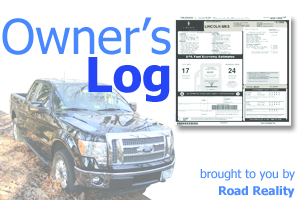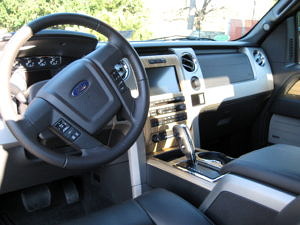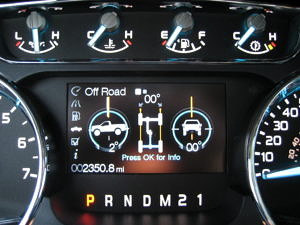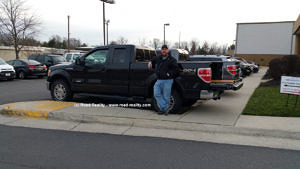 Christmas came early to our household this year! In an unexpected turn of events, the 2011 F-150 you’ve been reading about for over four years has been replaced. A good deal was made on a 2015 F-150 Lariat, the review of which will be posted in the coming weeks. Read on for my parting words for Ford’s bread-and-butter truck.
Christmas came early to our household this year! In an unexpected turn of events, the 2011 F-150 you’ve been reading about for over four years has been replaced. A good deal was made on a 2015 F-150 Lariat, the review of which will be posted in the coming weeks. Read on for my parting words for Ford’s bread-and-butter truck.
Stats:
Time Period: 10/19/2015 – 12/20/2015
Miles Driven: 1,288 / 36,389 (this update / total) (1,628 in last update)
Average MPG: 16.1 mpg (reported by on-board computer)
Avg MPG for Year: 16.2 (hand-calculated)
Costs:
Maintenance Costs: $0
Repairs: $0
Total Cost (non-fuel): $762.13
Services Performed:
- none
Summary:
 Out of all the vehicles I’ve owned in nearly 20 years of driving, the 2011 Ford F-150 was my favorite vehicle. I kept it the longest, had some really fun road trips, and used it like a truck as frequently as I could. Mechanically, it was sound, never having left me stranded. There were, however, a few hiccups with the techno-wizardry the engineers at Ford stuffed into it. With a baby on the way, and thus a need for a bigger cab, it was off to the dealership!
Out of all the vehicles I’ve owned in nearly 20 years of driving, the 2011 Ford F-150 was my favorite vehicle. I kept it the longest, had some really fun road trips, and used it like a truck as frequently as I could. Mechanically, it was sound, never having left me stranded. There were, however, a few hiccups with the techno-wizardry the engineers at Ford stuffed into it. With a baby on the way, and thus a need for a bigger cab, it was off to the dealership!
I mentioned reliability, and the warranty covered most of them, but I definitely recommend an extended warranty on any newer trucks or cars, with all the computers and screens being added to them (and before you ask, yes, we purchased the extended warranty on the new vehicle). The warranty repairs for the back window defroster and the front door speaker harnesses come to mind, as well as a rear parking sensor which went haywire when wet, all fixed by the local dealer. Hopefully all those issues have been resolved, since Ford went back to the drawing board for the 2015 F-150.
So, after four years and 36,000+ miles of driving, what do I think are the biggest hits and misses with the truck?
Hits: Exterior design, mechanical reliability, capability, some of the tech and luxury features, fuel economy.
Misses: Interior design, some of the tech and luxury features (mainly reliability of said tech).
 While I don’t have a lot of complaints, the competition really dated Ford’s F-150 interiors quickly. The hard plastics and plain, boxy design have been quickly surpassed by GM’s and RAM’s rounded, soft-touch dashboards. Also, some of the luxury items broke (touch screen, I’m looking at you – just not sure what I see, because your colors are all wonky). I know it’s still “just a truck,” but when the truck you’re buying has an MSRP in luxury-car territory, certain expectations need to be met – namely that you’re getting what you pay for.
While I don’t have a lot of complaints, the competition really dated Ford’s F-150 interiors quickly. The hard plastics and plain, boxy design have been quickly surpassed by GM’s and RAM’s rounded, soft-touch dashboards. Also, some of the luxury items broke (touch screen, I’m looking at you – just not sure what I see, because your colors are all wonky). I know it’s still “just a truck,” but when the truck you’re buying has an MSRP in luxury-car territory, certain expectations need to be met – namely that you’re getting what you pay for.
The aforementioned luxury amenities are what let me down about the 2011 F-150. At the time of trade-in, the touch screen’s colors had gone wonky, the passenger seat had started to wobble, the power rear sliding window stopped working altogether, and the sunroof broke in the tilted-up position. None of those things are to be expected, since they’ve been building cars and trucks with those options for years, and especially for such low mileage. Still, they weren’t enough to dissuade me from buying another F-150, they just pushed me to get the extended warranty. Using my Google-fu, I came up with a ballpark of between $3,500 and $4,000 to repair all those items. Not exactly chump change when you’re still making truck payments.
The hits though, far outweigh the misses. The boxy-but-rounded exterior styling still looks fresh, and in my eyes at least, it outshines the new Chevrolet Silverado/GMC Sierra design, especially the Silverado’s front end! Every crease and bulge adds to the handsomeness of the F-150, and even after 6 years (and now a full model year of the new body style), the 2009-2014 F-150s I see look great.
Another standout on the F-150 is the EcoBoost 3.5-liter V6. With its twin turbochargers, it churns out 365 horses and 420 torques, plenty of grunt for hauling people, cargo, trailers, or all three! The EcoBoost was a new engine for the 2011 model year F-150, and while there was a lot of grumbling from recalcitrant V8 truck guys, the market has truly spoken, and the EcoBoost is a solid winner. While I couldn’t find any exact numbers, it appears that V6 engines power over 40% of new F-150s sold since 2011, and I would bet that the vast majority of those are EcoBoosts, not the base 3.5-liter naturally-aspirated V6.
 I really can’t say enough good things about this engine. It’s powerful and relatively easy on the fuel gauge. Yes, it suffers from a little bit of “turbo lag” (quick synopsis: an inherent deficiency with turbocharged engines wherein there is a half-second delay between the gas pedal being pushed hard and the engine making all of its power), but the 21+ MPGs I saw on the highway more than make up for it.
I really can’t say enough good things about this engine. It’s powerful and relatively easy on the fuel gauge. Yes, it suffers from a little bit of “turbo lag” (quick synopsis: an inherent deficiency with turbocharged engines wherein there is a half-second delay between the gas pedal being pushed hard and the engine making all of its power), but the 21+ MPGs I saw on the highway more than make up for it.
Another hit is fuel economy. My truck spent most of its life in or near cities, with road trips interspersed at regular intervals. I’d wager that over 75% of its life was spent in stop-and-go and suburban traffic. In all that time, the truck averaged 16.47 MPG. Not too shabby! Year 2 (10/2012-10/2013) was the best year for fuel economy, at 16.88 MPG, with Year 4 (10/2014-10/2015) being the worst, at 15.74 MPG.  Coincidentally, Year 2 had the highest number of miles driven, while Year 4 had the fewest, which means I was driving the truck mainly in cold or foul weather, which would definitely factor into the poor fuel economy. For a truck that weighs close to 6,000 lbs, and can do all the things it did, I am impressed! Of course, different drivers will attain different levels of fuel economy, and I’ll admit that my right foot is a bit heavy, but tanks of gas spent driving on the highway usually netted 19.5-22.5 MPGs, which bookend the EPA’s rating of 21 MPG highway. The city number of 15 was harder to attain, simply because my commute is pock-marked with stoplights and traffic slowing the pace.
Coincidentally, Year 2 had the highest number of miles driven, while Year 4 had the fewest, which means I was driving the truck mainly in cold or foul weather, which would definitely factor into the poor fuel economy. For a truck that weighs close to 6,000 lbs, and can do all the things it did, I am impressed! Of course, different drivers will attain different levels of fuel economy, and I’ll admit that my right foot is a bit heavy, but tanks of gas spent driving on the highway usually netted 19.5-22.5 MPGs, which bookend the EPA’s rating of 21 MPG highway. The city number of 15 was harder to attain, simply because my commute is pock-marked with stoplights and traffic slowing the pace.
 Moving on, I had a few favorite features on the F-150. Most notable of these were the productivity screen and the high-resolution backup camera. The former is nestled in between the speedometer and tachometer, and provides the driver with a number of useful data points, including fuel economy, pitch & yaw angles, trailer information, and more. The latter has a dotted black line for easier hookup to trailers, and provides plenty of detail for safe backing in any situation.
Moving on, I had a few favorite features on the F-150. Most notable of these were the productivity screen and the high-resolution backup camera. The former is nestled in between the speedometer and tachometer, and provides the driver with a number of useful data points, including fuel economy, pitch & yaw angles, trailer information, and more. The latter has a dotted black line for easier hookup to trailers, and provides plenty of detail for safe backing in any situation.
 On the home front, my 5’3″ tall wife found the box side steps and tailgate step to be immensely helpful, and even at 5’8″ tall, they really helped me out when loading or unloading.
On the home front, my 5’3″ tall wife found the box side steps and tailgate step to be immensely helpful, and even at 5’8″ tall, they really helped me out when loading or unloading.
 As I look back after four years and 36,000+ miles, I’ll miss the old truck, but unlike many of my previous vehicles, I look back upon it fondly. I can only hope the new one treats me as well. And yes, there’s a board and a set of post-hole diggers I transferred from the 2011 F-150 to the new one. I really got some looks for that one!
As I look back after four years and 36,000+ miles, I’ll miss the old truck, but unlike many of my previous vehicles, I look back upon it fondly. I can only hope the new one treats me as well. And yes, there’s a board and a set of post-hole diggers I transferred from the 2011 F-150 to the new one. I really got some looks for that one!
by John Suit
